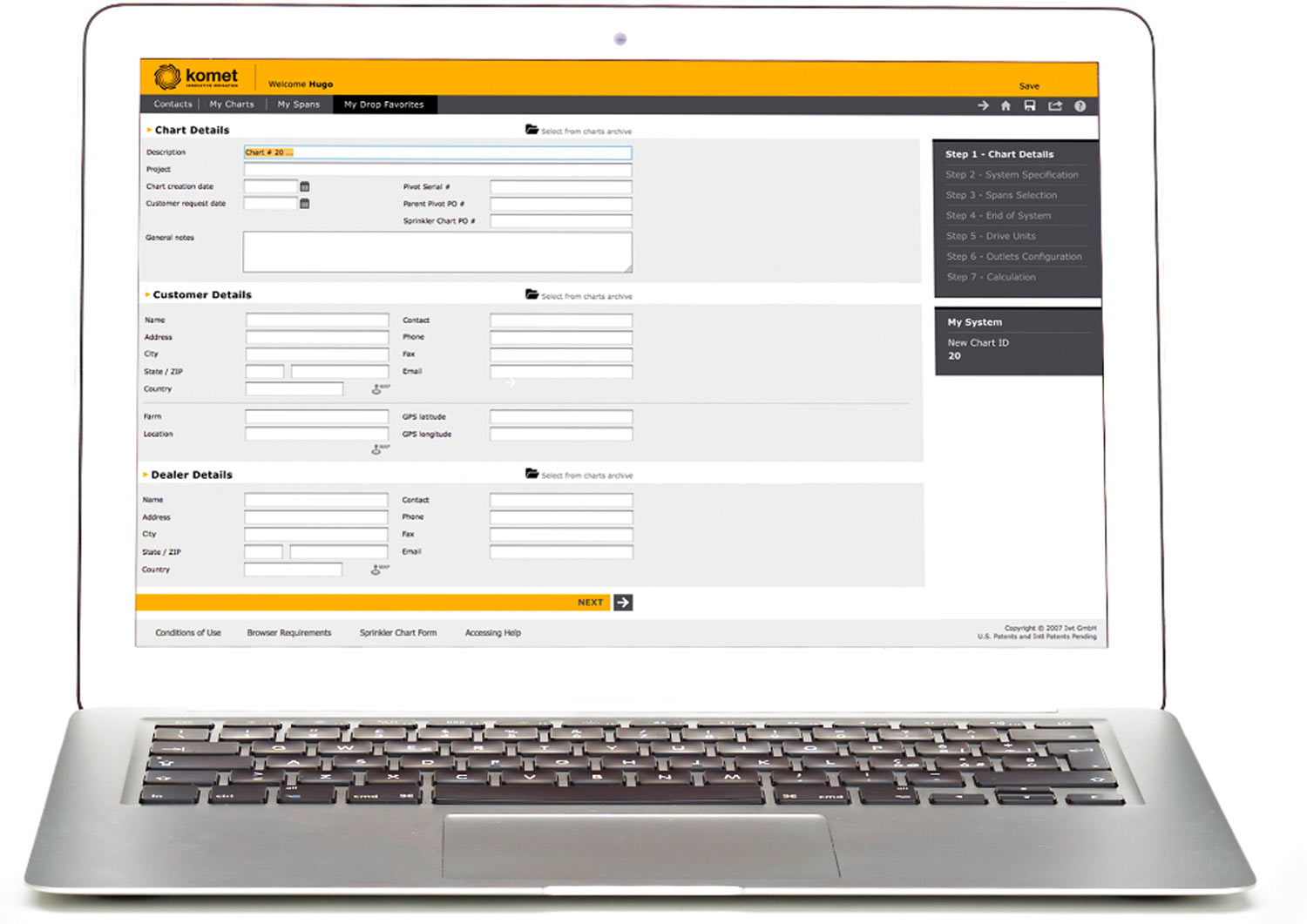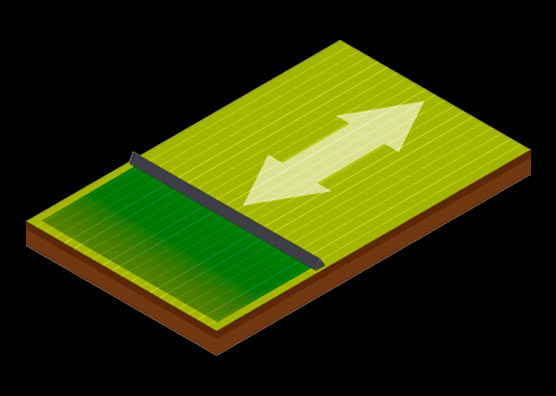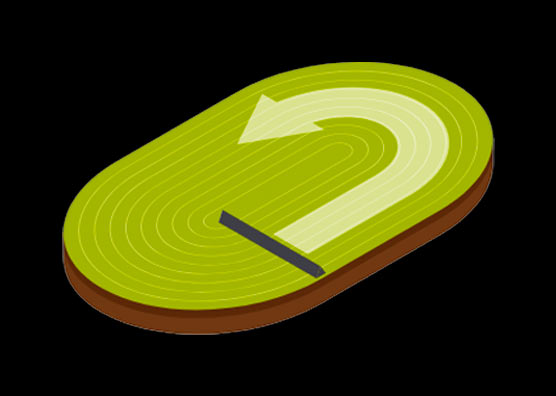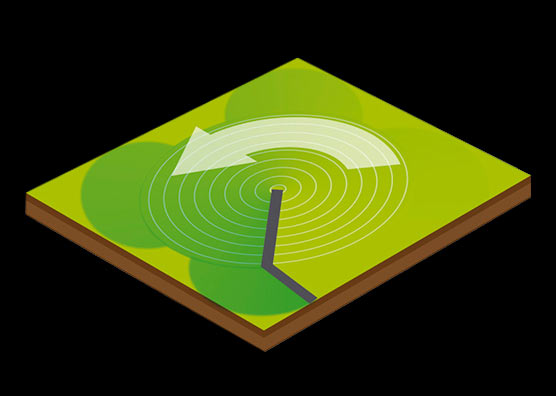The Komet Pivot Calculation Software is a powerful tool to calculate sprinkler charts for pivot irrigation systems. With the required information, such as pivot type, pressure, flow, elevation changes, and so on, the software tells you which outlets to equip and the respective nozzle sizes – always keeping in mind the most uniform water application possible. Our software not only offers the most sophisticated calculation logic on the market, but also provides the most extensive number of options of sprinkler chart types.
Pivot
Sprinkler
Products
Pivot
Software
Komet Pivot Calculator Software

Types of sprinkler charts
-
Pivot

-
Linear

-
Pivoting Linear

-
Pivot with corner arm

-
Pivot with stopping spans

Types of sprinklers
-
Sprinkler on drops

-
Sprinkler on top of pipe

-
Guns on top of pipe

Types of Reports
Komet Pivot Software
Perfection down to the last detail
When it comes to designing a new field irrigation system – or programming sprinkler system set-ups that are already in place – nothing should be left to chance. As outlined in our irrigation training webinar, successful irrigation relies on a complex interplay between the respective center pivot irrigation system, soil and crop. Consequently, a sprinkler system should always be configured in perfect alignment with the type and developmental stages of the irrigated crop, as well as the topography and composition of the soil.
Among the core elements of mechanized irrigation is a sprinkler system’s application rate. In essence, the application rate must correspond to the infiltration rate of the soil: Heavier soils, for example, will have a lower infiltration rate than lighter soils, as there are fewer open spaces for the water to travel through – meaning that the water will take longer to make its way to the root zone. Consequently, a lower application rate would be needed in order to allow sufficient time for infiltration and prevent surface pooling. This has to be reflected in the specifications of the chosen pivot sprinklers, and taken into account when programming a sprinkler system.
It is also important to remember that the irrigation requirements of plants differ throughout their various stages of development. During the germination period, for example, it is best to avoid sprinklers with heavy streams to prevent the risk of dislodged seeds or damaged seedlings. Which brings us to the importance of an optimal droplet size: If the droplets are too small, they are vulnerable to misting, wind drift and evaporation; droplets that are too large, on the other hand, can lead to soil sealing and compaction.
Another important factor of a well-designed sprinkler system is the correct sprinkler spacing: In order to avoid the risk of streaking, there should be a minimum of 150% overlap between each sprinkler – whereby the exact spacing will depend on the throw radius of each individual sprinkler, as well as the respective ground clearance and mode of installation.
There are, of course, general guidelines for optimal spacing along the different spans – depending, in part, on whether the sprinklers are installed above the crop canopy, in the upper / lower canopy, or top-of-pipe. However, as with all of the above-mentioned factors, these parameters should be calculated (rather than estimated) for optimal results. In other words: The best way to build a perfect sprinkler system and achieve efficient, high-precision irrigation, is to utilize a center pivot irrigation calculator.
Komet’s Online Pivot Program:
A center pivot irrigation calculator designed for ultimate precision, ease of use and comprehensive reporting
Designed as an internet-based pivot program, Komet’s sprinkler design software is stored in the Cloud. This decision in itself offers several advantages compared to other sprinkler calculator products on the market. For one, there is no need for users to repeatedly download new updates to their own devices, as Komet’s online pivot software is updated automatically. Secondly, all entered data will be safely retained, even if the customer’s computer should crash or experience other technical or hardware problems. Another trait that sets Komet’s sprinkler design software apart from similar programs is its user-friendliness: Instead of presenting an open-ended array of combinations that would be impossible to implement in any real-life scenario, the available options are automatically narrowed down, on the basis of feasibility, at every step of the selection process. As a result, users are guided towards realistically operational sprinkler system configurations.
Another benefit of Komet’s sprinkler design software is its flexibility. Komet’s pivot software offers the most extensive range of sprinkler charts on the market, catering to the following types of irrigation set-ups: Center pivot without corner arm; center pivot with corner arm; linear / lateral moving irrigation systems; combined center pivot and linear / lateral irrigation systems (hippodrome); and articulated center pivot irrigation systems (flexing pivot).
By entering specifications such as pivot type, pressure, flow, elevation differences etc. into the software program, users are able to configure a sprinkler system with the correct spacing and nozzle sizes to achieve the best possible uniformity.
As well as utilizing the most sophisticated calculation logic on the market, Komet’s pivot software also offers a comprehensive reporting system, which allows customers to share their sprinkler charts with third parties (whereby the report can also double as an installation manual), or keep their irrigation software results both for future reference and possible adjustments. The reports can be printed out in US Letter or A4 format. Komet’s sprinkler design software comes in four languages – English, French, Spanish and Portuguese – with a choice between imperial and metric measurements. For added convenience, users are able to input details using one measurement system, but then opt for an automatic conversion for the final report.
Working with Komet’s software is very straightforward. After logging in with their respective username and password, customers are able to create a new sprinkler chart, or review and adjust a chart they have previously saved (for example, when re-nozzling or re-outletting an existing center pivot irrigation system). For easy identification, each chart can be marked with a number and project name and/or description. Users are also able to compile a selection of favorites, in order to create convenient shortcuts to frequently accessed details.
For the first step in Komet’s pivot software, users select their preferred input measurement unit (metric or imperial), the type of irrigation system (e.g. center pivot), the span profile, as well as the existing (or, alternatively, the required) pressure. The pivot point calculator software also takes into account the elevation differences along the irrigation system. To this end, users can either specify the highest field elevation in relation to the pivot point, or click on the ’SELECT GPS POSITION’ button. The latter lets you enter the GPS coordinates of the pivot point (or, in the case of a moving irrigation system, the linear cart); the program then calculates the area covered by the sprinkler system, and displays it in Google Maps. General information – such as the water source, water quality, climate, soil texture, crop type, etc. – can also be selected or entered into the respective fields.
Step 3 of Komet’s pivot software allows users to compile their irrigation system by selecting a range of different criteria – such as manufacturer, span type (e.g. first span, transition joint, last span, corner arm, overhang, etc.), as well as span diameter, length, and nominal outlet spacing. In addition, Komet’s pivot software provides a LEPA (Low Energy Precision Application) Re-Outlet option, whereby the distance between outlets can be adjusted in line with the intended crop row spacing. The tower height of each individual span can also be altered, provided the ‘Height of Span Profile Varies Along the System’ option has been selected. Otherwise, the tower heights will be displayed as per the manufacturer’s specification.
Once all details have been specified, Komet’s software will display a draft image of the irrigation system, detailing its total length.
The End of System page in Komet’s pivot program allows users to specify which devices will be installed at the outer spans – such as end guns, a booster pump, drain sprinkler or valve. The next section of the procedure is dedicated to drive units: On this page, users are able to enter details about their irrigation system’s motor, tire size, ground speed (measured in meters/feet per minute), and much more. The program then uses this information to calculate the drop hose lengths and water application rate.
The Outlets Configuration page focuses on the irrigation system’s drop components and wheel track options, and allows growers to specify the ground clearance, sprinkler types and (if desired) a user-defined outlet filling pattern. Komet’s sprinkler design software also offers additional possibilities, such as calculating the over-the-truss-rod length of a specific drop, or determining the orientation of double drops at 45° (instead of the standard 90°).
Once all relevant details have been selected, the irrigation program calculates the sprinkler chart, and performs an automatic quality check. Should the configuration not be feasible, a pop-up window will appear, detailing the issue that needs to be resolved.
The Calculation page allows customers to review the outlets on the irrigation system as proposed by the pivot software’s calculation. In addition, users are able to access the Reports page, the Warnings page (containing detailed information about discrepancies the program may have detected), as well as a Water Distribution Chart.
